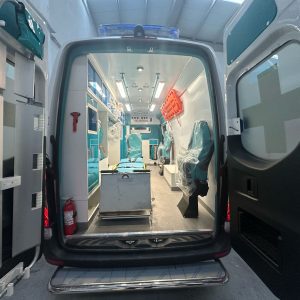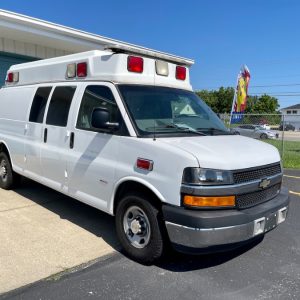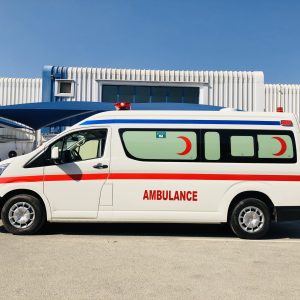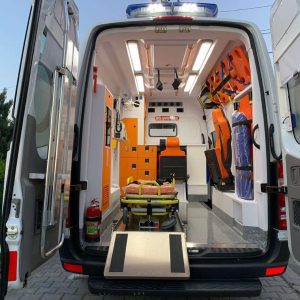1. Introduction to Hiace Ambulances
Hiace ambulance van is specifically designed for hospital or commercial membership club ambulance service. While “ambulance” is a term associated with emergencies and accidents, the beautiful and clean appearance of Hiace ambulances serves as a source of great motivation for riders and road passengers. Hiace ambulances are used for transporting patients from one place to the hospital. The seats can be easily removed to provide expansion of the ambulance body. Toyota Hiace model of ambulances is locally assembled and equipped with the latest medical equipment, which is also available in some other brands. 200,000 ambulances are used for transporting patients between hospitals, to special treatment centers, and for residential transport.
Ambulances are also used for emergency medical services. For this operation, Hiace model of ambulances is used, which is fully equipped with a wide range of lifesaving and stabilizing medical equipment. They are operated by a team of at least one emergency medical technician and a driver. Hiace ambulances can respond to your most essential medical needs. In case of a serious accident scenario, the patient is transported to the hospital, providing paramedics care continuously while driving to hospitals. During this period, an on-site expert physician in the emergency room can have important information about the patient’s health conditions, which can be helpful to plan treatment of first aid and treatment in the emergency room. Emergency ambulances use all the latest technologies in preventing injuries that are available in the field of treatment, where each second is crucial.
1.1. Key Features and Specifications
An overview of a Hiace Ambulance
The Toyota Hiace is a popular ambulance in Australia, but is also widely used in a number of countries around the world. The Hiace is adapted to be used as a small ambulance, with a narrow chassis. The design team must consider medical equipment size, as well as equipment placement, during the design phase of the ambulance kits right through to the completion phase. The first part of the kit to be designed to suit the Hiace is the module which will carry the medical equipment because everything else will be designed around this. Having the module designed and manufactured first will limit any possible conflict issues with equipment and allow all the pieces to fit. The kit rules regarding equipment prohibited will be more rigorously adhered to in the standard healthcare dependent kit as there will be less free space in the Hiace ambulance in which to place the equipment. It is important to note: The best Hiace kit for the drivers and ambulance personnel is the Medimate/SAAS Standard Health Care Depend/K Changes Variation One as it gives the drivers the best room to move and the best sight lines. The only reason some installations might get the Hiace ambulance for the Wealth Care Depend K is if the Standard Health Care Depend K is not in production for some reason.
Features of a Hiace Ambulance Technical Specifications Hiace Type of Vehicle: Van Engine Kit: 1 KZ-TE Model: 2005 Body: Metal with fiberglass ambulatory compartment Transmission: Manual Cabin: 3 occupant Berths: 2 stretchers with the ability to carry 2 standing or sitting patients in the rear. The Hiace ambulance module is designed to be fitted into the van rear load area so that the patient can slide as quickly as possible from the attending team to the treatment table at the rear when dealing with say a casualty from a car accident. When not on a stretcher & being carried in the ambulance, the patient can sit side-on comfort in the stretcher or lay on his own back on the stretcher. The stretcher will not allow the patient to lay on his/her stomach and be carried inside the ambulance. The Toyota Hiace with an ambulance module has limited concurrent cognition volume inside. More parties there are in the van can restrict more research not being used point to racks that will hold technical equipment. If all place is taken by patients on stretchers then you are in difficulty you are going to have to treat in the back and not in the saloon. The following technical specifications help us understand what makes the kit fit so well into the Hiace Ambulance. Base Length: 3.24 *Base Width: 1.71 *Top Length: 3.24 *Top Width: 1.71 *Front Height: 1.35 Overall Height: 1.74 *SQ Volume: 9.95 *Head Height: 0.35 *Access Door Height: 1.710 *Right Rear Internal 72 CM for all height measurements *Internal Front Height: 1.32 *Front Height with Flooring: 1.41 *Floor Height only: 0.125.
2. Importance of Medical Equipment in Ambulances
The world over, hospitals and health services rely on ambulances to carry patients to facilities across the country. However, for any journey to remain uninterrupted, it is crucial that the ambulance is equipped with the right medical equipment. Ambulance equipment serves a critical purpose and is often the difference between circumstances that range from saving a life to fixing the broken pieces as much as possible in case disaster strikes. The availability of specific medical equipment, such as biomedical engineering equipment, can be of great importance when it comes to saving lives in an emergency, trauma, or accident. For basic life support services (BLS) and more advanced life support, patient care has the right to a certain range of medical devices.
A Hiace ambulance is equipped with medical devices as well as a stretcher capable of carrying patients and an accompanying device. Such equipment is commonly used to maintain the airway, ventilate, resuscitate, circulate, and immobilize injured and sick people. Ambulance equipment is part of the transportation of patients, which carries a variety of tools for transporting patients from one hospital to another. An ambulance can carry all the drugs and medical devices to treat critically ill patients during transport. The following are equipment that are mandatory and must-haves in Hiace ambulances.
2.1. Role in Emergency Medical Care
The use of ambulance services in countries all over the world significantly contributes to the improvement of patients’ health and the entire healthcare system. Advanced and developing systems base their services on providing emergency medical care on site and during transport and receiving care only at well-established hospitals. In the provision of emergency medical care at accident scenes, the area of medical care, and equipment that is closely related to it and has a significant influence are indispensable. If such supplies and equipment are organized properly, the safe provision of medical care in ambulances may be an aspect that reassures citizens and encourages them to continue using them.
Hereinafter, medical equipment installed in Hiace ambulances will be explained based on its usage. Information that patients are not aware of regarding Hiace ambulances might help them feel secure when using such services. Medical equipment to be used in Hiace ambulances can be categorized based on its usage. In short, they form the following three groups: (i) medical equipment used in the provision of emergency care at accident scenes where patients first receive care, (ii) medical equipment used for transport operations, when patients receive care away from home on board an ambulance while they are being conveyed to a hospital for further treatment, and (iii) medical equipment used for providing emergency care to patients who are in transit, to be used only when absolutely necessary.
3. Types of Medical Equipment in Hiace Ambulances
There are many types of medical equipment that are installed in an ambulance vehicle. They are classified into basic medical equipment and advanced medical equipment.
Basic Equipment The main use of the basic observation device is to observe the physiological parameters of the casualties, determine the timing of first aid, and whether the changes made in the process of first aid are effective. Sphygmomanometers, stethoscopes, and thermometers are the most commonly used. They have no effect on the condition, do not cause secondary injuries to the injured, and can objectively reflect the various objective conditions of the injured. The main use of trauma dressing and basic dressing is to deal with various wounds, prevent the invasion of external pathogens, facilitate the healing of various wounds, and greatly reduce the mortality of disasters. Commonly used trauma dressings are hemostatic gauze, sterile gauze, and an umbrella cloth. Disposable insulation cloth, etc.
Advanced Equipment Advanced equipment can maintain patients with vital signs and provide billion-dollar life support measures such as invasive treatment, pain relief, sedation, hemostasis, etc. in critical conditions. It can reduce and eliminate secondary injuries and treatment injuries. The main purpose of a portable ventilator is to enable patients to establish and maintain airway patency and improve respiratory function. The stabilizer is mainly used to fix and support cervical spine injury patients. Brain function is the first function of the body that is damaged or evaluated early when an accident occurs. The main function of a human monitor is to assess the important life indicators of the human body in real time. Once there is a problem, it is dealt with in time, and there are blood pressure monitoring, heart rate monitoring, and oxygen saturation monitoring. Throughout the development of the trend, the medical equipment in the car continues to simplify and integrate, providing driver control functions to simplify the car’s workload. At the same time, it is more humane to maintain the stability of the patient’s condition.
3.1. Basic Equipment
In every Hiace ambulance, we find a particular set of medical equipment necessary for immediate medical attention and care of patients on the way to a better-equipped hospital. This medical equipment in the ambulance can be divided into the following groups: basic equipment (airway management systems, transport and immobilization equipment, simple diagnostic equipment, oxygen supply systems, basic therapeutic medications).
The first complete medical equipment necessary in the first contact should help to maintain the patient’s basic vital functions and their assessment. This primarily concerns the respiratory and circulatory system. It is primarily used to access the respiratory system (administer oxygen and aspirate the respiratory secretion). The assessment of respiratory efficiency and heart function is possible using standard assessments, auscultation, and pulse rating. The pain-intensifying scene did hurt. Patients who are conscious may be given simple painkillers if the patient suffers uncontrolled pain. It is important to monitor circulation. In a patient with a decreased level of consciousness, the supply of oxygen, if there is a respiratory disorder, allows the pulse to decrease or become arrhythmic. However, in a patient whose level of consciousness is high but circulatory shock has not yet been detected (normal pulse regular pulse), oxygen and painkillers can be administered to enable us to adjust the circulatory damage of these agents.
3.2. Advanced Equipment
Hiace ambulances also come with various advanced medical equipment, including defibrillators. A defibrillator is a device that delivers an electric shock to a patient experiencing cardiac arrest. This shock helps the heart revert to its correct rhythm. Some Hiace ambulances are also outfitted with back-up defibrillators in case of machine failure. C- and D-size oxygen cylinders are also standard inclusions in a Hiace ambulance. Large-capacity cylinders are well-suited to the extended transportation times often required in rural settings.
Advanced equipment also includes manual suction units. Even though Hiace ambulances have their own air-conditioning systems, this suction unit provides a failsafe method of removing obstructions from a patient’s airway in the event of air-conditioner failure. Hiace ambulances also come with large IV equipment bags. Smaller kits, similar to those found in commercially available first-aid kits, are kept in the door of the ambulance, which allows a paramedic to access the tools they need quickly. Similarly, durable grab bags rated to carry loads ranging from 3 to 5 kg are also included in the ambulance. The grab bags hold tubing, tongs, dressing scissors, tape, lotions, gloves, oxygen masks, morphine, Endone, paracetamol, intravenous fluids, cannulas, syringes, and hand towels. Much of this equipment is now also carried on bariatric stretchers, effectively eliminating the need for the grab bags. Other common medical items in the grab bag include a patient warning sign, capillary sample tubes, band-aids, disposable pillows, tranquillizers, airway devices, cannulation pods, an AED, automatic blood pressure monitors, and manual blood pressure monitors.
4. Maintenance and Safety Protocols Hiace Ambulance
AU Standard 192-20, a document provided by Land Transport New Zealand which is to come into force in November 2002, will have a significant effect on the management, training of technical staff, and the quality of service that St John offers the public. AU192-20 outlines the minimum requirements for crews that operate the vehicle and their training needs and practices. Of major concern to management will be the maintenance and safety certification practices, policies, and procedures set by the implementing standard.
In regard to managers of vehicle workshops, the questions asked regarding medical equipment in the Hiace ambulances are: – What medical equipment needs to be provided in the vehicle? – How should it be managed and maintained? – How will it be kept clean, sterile, and handled?
Equipment located in the rear of ambulances will be subjected to changes in temperature, shock, and vibration from road travel, and changes in pressure when traversing hills and during bad weather. The intensity of a patient transfer can’t be determined before this occurs. The following maintenance, training, and management requirements are suggested with the best interests of St John and our patients in mind: – A technical file is to be kept at the station and workshop. This must be accessed by station personnel and the area manager. – Each piece of equipment is independently dispatched, and the maintenance record for that piece of equipment must be removed from the file and taken by ambulance staff. – Maintenance schedules for ambulances and medical equipment should be linked. – Equipment is to be recorded as checked by the board and will have a piece of blue label attached – these too should be completed on the day of the maintenance check and the month/year initialed. – Maintenance and cleanliness record books will be stored on the workshop floor and stored upright in a clean condition.
4.1. Regular Inspection and Calibration Hiace Ambulance
One of the obligations of the Non-Emergency Transport (NET) service providers that operate AWD Hiace ambulances is to provision and maintain certain medical equipment. This is to ensure that when certified NET service providers perform emergency patient transport service (EPTS), the NET service provider staff can deliver first aid and manage a patient during transport to professional medical attention (PMTA) in a registered EPTS vehicle. Additionally, NET service providers may also perform pre-scheduled patient transport services (PTS), which also requires a crew member trained to provision basic patient care. The importance therefore is to ensure that all medical equipment located within AWD Hiace ambulances is regularly checked to make sure it is functioning. This includes regular replacement of devices and consumables and calibration of instrumentation as required.
Equally, it is important to take relevant action if equipment is found to be out of order on regular inspection, or is suspected to be, as part of duty-of-care obligations for the adults and children awaiting transport in, or being transported in, an AWD Hiace miles. The cleaning of ambulances after every undertaking of emergency patient transport service, involving all equipment including medical devices (as well as all contact points, potentially contaminated surfaces, and vehicles in general), remains applicable after any undertaking of emergency patient transport services, as all patients may have an infectious disease. The way NET service providers can ensure compliance with the regulatory obligations of the EEPTS before each and every emergency undertaking (before the vehicle doors are secured and locked) is to have regular practices in place to monitor and review. Basic protocols outlined in this document for checking routine items is not owner-operated or stock/equipment-related but an example for a new owner. It is the essential practice of maintenance of functionality and reliability of medical equipment.
5. Future Trends and Innovations Hiace Ambulance
The future of medical equipment in Hiace ambulances is promising, as it aims to preserve and improve the survival rate of patients. The current advances in medical imaging technologies and data analytics capabilities result in great volumes of high-quality and high-dimensional data. The use of big data techniques can enhance the prediction and diagnosis of patient issues, and many efforts are being invested in that matter worldwide. Local transportation can be motivated and enhanced to be more responsive to individual patients’ conditions and pathologies, providing adequate medication and doctors en-route to the hospital. In the future, Hiace ambulances are expected to assume the shape of compact mobile hospitals.
When a call is placed and the Hiace ambulance is alerted, the patient’s information is automatically sent to the Hiace ambulance computer system to calculate the urgency of the patient’s case. This system sends an SMS text message to the mobile Hiace ambulance unit nearest the patient’s location. By the time the paramedics are dispatched to the patient, they are familiar with the case and are prepared to offer the patient first aid, as the computer would have suggested the needed first aid material to be placed in the Hiace ambulance en-route to the patient. High-definition images of the patient are transmitted to the hospital’s computer network for the staff to discuss the condition of the patient while the Hiace ambulance is on its way to the hospital. The future value of this trend is to deliver full medical transportation services and a portable steel-structured single patient compartment inside the Hiace. There will be injectors for emergency situations to deliver drugs intravenously to the patient. The ambulatory bed enables the patient to lie down inside the Hiace. A portable X-ray machine or ultrasound machine could be used en-route to see the condition of the patient.

































